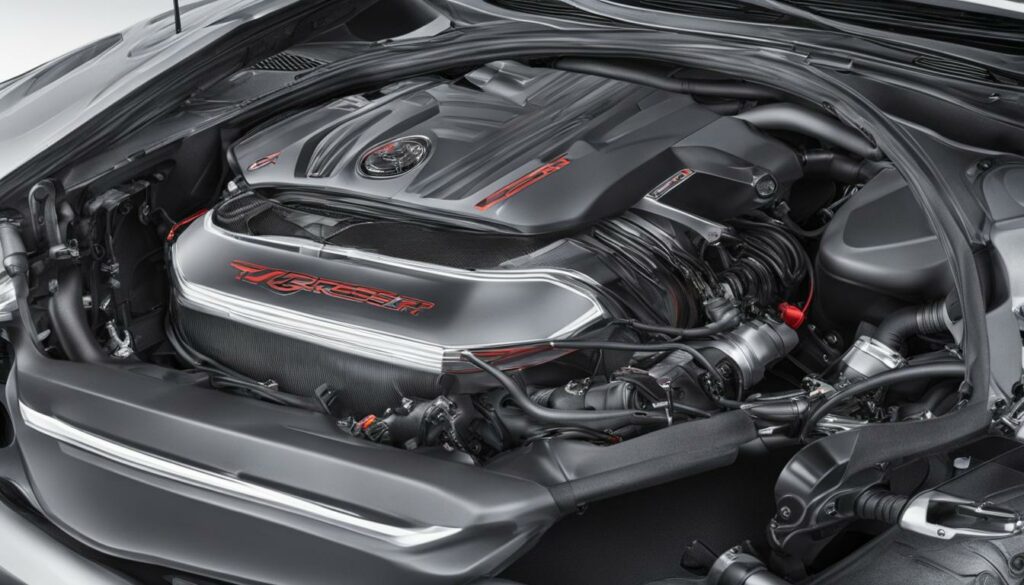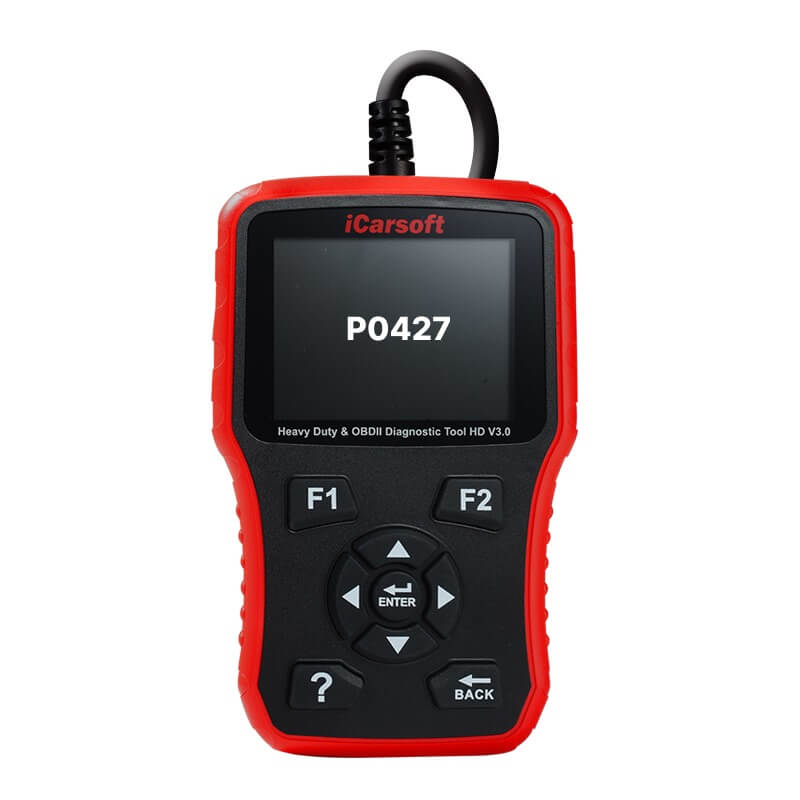P0427 – Catalyst Temperature Sensor Low
POSTED IN pcodes
Welcome to our article on the P0427 code. In this guide, we will explore everything you need to know about the P0427 code, its causes, symptoms, diagnosis, and repair options. The P0427 code is an OBD-II trouble code that indicates an issue with the catalyst temperature sensor in engine bank 1. This code is important for automotive diagnostics as it relates to vehicle emissions, engine performance, and overall troubleshooting for automotive repair.
Key Takeaways:
- The P0427 code is an OBD-II trouble code related to the catalyst temperature sensor in engine bank 1.
- A faulty catalyst temperature sensor, poor electrical connection, or damaged catalytic converter can trigger the P0427 code.
- The symptoms of the P0427 code are typically limited to an illuminated Check Engine light.
- To diagnose the P0427 code, a mechanic will use an OBD-II scanner and perform a visual inspection.
- Common mistakes when diagnosing the P0427 code include not addressing related codes and failing to determine the underlying cause.
What Causes the P0427 Code?
The P0427 code is triggered when there is a problem with the catalyst temperature sensor in engine bank 1. Several factors can contribute to the occurrence of this code, including:
- Faulty catalyst temperature sensor
- Poor electrical connection to the sensor
- Shorted or open connection with the sensor’s harness
- Faulty or damaged catalytic converter
- Exhaust leaks before or in the catalytic converter
These issues can disrupt the proper functioning of the catalyst temperature sensor, leading to an inaccurate temperature reading and the subsequent storage of the P0427 code.

Common Causes of the P0427 Code
| Cause | Description |
|---|---|
| Faulty Catalyst Temperature Sensor | The sensor may be defective, providing incorrect temperature readings to the PCM. |
| Poor Electrical Connection | Issues with the wiring or connectors can result in intermittent or inconsistent sensor readings. |
| Catalyst Temperature Sensor Harness | A shorted or open connection within the sensor’s harness can lead to incorrect temperature readings. |
| Faulty Catalytic Converter | A damaged or inefficient catalytic converter affects the overall performance of the exhaust system, leading to abnormal sensor readings. |
| Exhaust Leaks | Leaks before or in the catalytic converter can introduce additional oxygen into the exhaust system, interfering with the sensor’s readings. |
Identifying the specific cause of the P0427 code requires a methodical diagnostic process using professional tools like an OBD-II scanner. This process can help pinpoint the root cause of the issue and guide the necessary repairs.
Buy tested tuning file for Adblue / EGR / DPF / Adblue off now!
What are the symptoms of the P0427 code?
In most cases, the only noticeable symptom of the P0427 code is an illuminated Check Engine light. The vehicle’s performance and fuel economy are generally unaffected, and there are no noticeable changes in emissions. However, it is crucial to address the code promptly to prevent potential issues and to pass OBD-II emissions testing for registration.

It’s important to note that although there may not be any obvious signs of trouble, the presence of the P0427 code indicates an underlying problem with the catalyst temperature sensor or catalytic converter. Ignoring the code could lead to further complications down the line, such as reduced engine performance or even catalytic converter failure.
How does a mechanic diagnose the P0427 code?
When faced with the P0427 code, a mechanic employs the use of an OBD-II scanner to initiate the diagnostic process. The first step is to check if any related codes have been stored and address those issues first. By resolving related codes, the mechanic ensures a thorough diagnosis of the underlying problem.
If the P0427 code persists after rectifying related codes, the mechanic will proceed to determine if the catalytic converter is covered under warranty. If applicable, the mechanic will strictly adhere to the manufacturer’s guidelines for addressing the warranty claim. Catalytic converter issues can be resolved, at least partially, by utilizing the warranty.
Following the warranty assessment, a visual inspection of the catalyst temperature sensor, its harness, and all associated electrical connections is carried out. Identifying any faults or irregularities in these components can provide valuable insights into the cause of the P0427 code.
If the issue is not with the sensor, the mechanic will then focus on checking for exhaust leaks or oxygen leaks in and around the catalytic converter. Such leaks can lead to improper functioning of the converter, triggering the P0427 code.
The diagnostic process requires attention to detail, careful examination of components, and the use of specialized tools such as the OBD-II scanner. By following a systematic approach, mechanics can accurately diagnose the P0427 code and identify the necessary repairs.
Common mistakes when diagnosing the P0427 code
When diagnosing the P0427 code, it’s essential to avoid common mistakes that can lead to unresolved issues and potentially result in catalytic converter failure. Thoroughly inspecting and diagnosing the cause of the code is crucial to ensure an accurate and effective repair.
- Failing to address unresolved related codes: One common mistake is neglecting to investigate and resolve any related codes that may have been stored alongside the P0427 code. These related codes can provide valuable insights into the underlying issues that need to be addressed. By overlooking them, the root cause of the P0427 code may remain unresolved, leading to recurring problems and potential catalytic converter failure.
- Repetitive replacement of the catalytic converter: Simply replacing the catalytic converter without identifying the underlying cause of the P0427 code is another common mistake. While a faulty catalytic converter can trigger the P0427 code, it may not always be the primary cause. By solely focusing on the catalytic converter, other contributing factors such as a faulty catalyst temperature sensor or exhaust leaks may be overlooked. This can result in repeated catalytic converter failures and costly repairs.
- Inadequate comprehensive diagnosis: Conducting a comprehensive diagnosis is crucial when dealing with the P0427 code. This involves thoroughly inspecting all components involved, including the catalyst temperature sensor, its wiring harness, and electrical connections. Additionally, checking for exhaust leaks or oxygen leaks before or in the catalytic converter ensures all potential causes are identified. Failing to perform a comprehensive diagnosis may result in incomplete repairs and persistent issues.
To effectively address the P0427 code and prevent further complications, it’s important to avoid these common mistakes and approach the diagnosis with meticulous attention to detail. By taking the time to thoroughly investigate and address all potential causes, you can ensure a successful repair that resolves the P0427 code and prevents catalytic converter failure.
Example Table:
| Mistake | Consequence | Solution |
|---|---|---|
| Failing to address unresolved related codes | Root cause of P0427 code remains unresolved, potential catalytic converter failure | Investigate and resolve all related codes to identify underlying issues |
| Repetitive replacement of the catalytic converter | Potential recurring catalytic converter failures, increased repair costs | Thoroughly diagnose the cause of the P0427 code before replacing the catalytic converter |
| Inadequate comprehensive diagnosis | Incomplete repairs, persistent issues | Conduct a thorough inspection of all components and check for exhaust leaks |
Conclusion
The P0427 code indicates a problem with the catalyst temperature sensor and catalytic converter in your vehicle. To diagnose and repair this issue, it is crucial to conduct a thorough inspection and diagnosis, addressing any related codes and identifying the root cause of the problem. By properly maintaining your vehicle and addressing the P0427 code promptly, you can prevent expensive catalytic converter failure and ensure compliance with emissions testing.
Timely repairs and maintenance are key to optimizing engine performance and reducing the risk of further damage. If professional assistance is unavailable, an alternative solution is to permanently remove the P0427 code by uploading the Engine Control Unit (ECU) file to a specific portal. However, it is important to note that diagnosing the P0427 code and addressing the underlying cause is the best approach to ensure long-term reliability and performance of your vehicle.
By understanding the significance of the P0427 code and taking proactive measures, such as regular vehicle maintenance and prompt repairs, you can protect your catalytic converter, optimize engine performance, and contribute to a greener environment. Remember, addressing automotive issues promptly leads to safer and more efficient vehicles in the long run.
FAQ
What is the P0427 code?
The P0427 code is stored when the PCM detects that the catalyst temperature sensor is reading a lower temperature than the acceptable range in engine bank 1. This code indicates that the catalytic converter is not operating efficiently and could be caused by a faulty catalyst temperature sensor, poor electrical connection, or a damaged catalytic converter.
What causes the P0427 code?
The main cause of the P0427 code is an issue with the catalyst temperature sensor in engine bank 1. This can be due to a shorted or open connection with the sensor’s harness, a faulty or damaged sensor, or a poor electrical connection to the sensor. Another possible cause is a faulty or damaged catalytic converter. Exhaust leaks before or in the catalytic converter can also trigger the P0427 code.
What are the symptoms of the P0427 code?
In most cases, there are no discernible symptoms of the P0427 code other than an illuminated Check Engine light. The vehicle’s performance and fuel economy are generally unaffected, and there are no noticeable changes in emissions. However, it’s important to address the code promptly to prevent potential issues and to pass OBD-II emissions testing for registration.
How does a mechanic diagnose the P0427 code?
A mechanic will use an OBD-II scanner to diagnose the P0427 code. They will check if any related codes have been stored and address those issues first. If the P0427 code is stored again, they will determine if the catalytic converter is under warranty and follow the manufacturer’s directions if applicable. A visual inspection will be conducted on the catalyst temperature sensor, its harness, and any electrical connections. If the issue is not with the sensor, the mechanic will check for exhaust leaks or oxygen leaks before or in the catalytic converter.
What are common mistakes when diagnosing the P0427 code?
One common mistake when diagnosing the P0427 code is failing to thoroughly inspect and diagnose the cause of the code. It’s important to address any related codes and determine their underlying causes before addressing the P0427 code. Simply replacing the catalytic converter without identifying the root cause can result in repeated failures and potential catalytic converter failure. It’s crucial to conduct a comprehensive diagnosis to prevent further issues.
What should I do if I have the P0427 code?
If you have the P0427 code, it is recommended to take your vehicle to a mechanic for diagnosis and repair. They will be able to identify the exact cause of the code and perform the necessary repairs. Promptly addressing the P0427 code will help to maintain optimal engine performance and reduce the risk of further damage.


